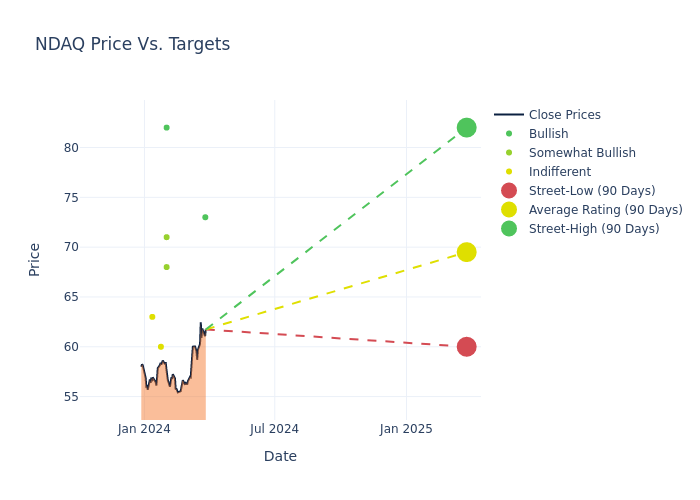During the last three months, 6 analysts shared their evaluations of Nasdaq NDAQ, revealing diverse outlooks from bullish to bearish.
The table below summarizes their recent ratings, showcasing the evolving sentiments within the past 30 days and comparing them to the preceding months.
| Bullish | Somewhat Bullish | Indifferent | Somewhat Bearish | Bearish | |
|---|---|---|---|---|---|
| Total Ratings | 2 | 2 | 2 | 0 | 0 |
| Last 30D | 1 | 0 | 0 | 0 | 0 |
| 1M Ago | 0 | 0 | 0 | 0 | 0 |
| 2M Ago | 1 | 2 | 0 | 0 | 0 |
| 3M Ago | 0 | 0 | 2 | 0 | 0 |
Providing deeper insights, analysts have established 12-month price targets, indicating an average target of $69.5, along with a high estimate of $82.00 and a low estimate of $60.00. Witnessing a positive shift, the current average has risen by 12.55% from the previous average price target of $61.75.

Interpreting Analyst Ratings: A Closer Look
The standing of Nasdaq among financial experts becomes clear with a thorough analysis of recent analyst actions. The summary below outlines key analysts, their recent evaluations, and adjustments to ratings and price targets.
| Analyst | Analyst Firm | Action Taken | Rating | Current Price Target | Prior Price Target |
|---|---|---|---|---|---|
| Alexander Blostein | Goldman Sachs | Announces | Buy | $73.00 | - |
| Richard Repetto | Piper Sandler | Raises | Overweight | $71.00 | $70.00 |
| Owen Lau | Oppenheimer | Raises | Outperform | $68.00 | $65.00 |
| Andrew Bond | Rosenblatt | Maintains | Buy | $82.00 | - |
| Alex Kramm | UBS | Raises | Neutral | $60.00 | $56.00 |
| Christopher Allen | Citigroup | Raises | Neutral | $63.00 | $56.00 |
Key Insights:
- Action Taken: Analysts adapt their recommendations to changing market conditions and company performance. Whether they 'Maintain', 'Raise' or 'Lower' their stance, it reflects their response to recent developments related to Nasdaq. This information provides a snapshot of how analysts perceive the current state of the company.
- Rating: Analysts unravel qualitative evaluations for stocks, ranging from 'Outperform' to 'Underperform'. These ratings offer insights into expectations for the relative performance of Nasdaq compared to the broader market.
- Price Targets: Delving into movements, analysts provide estimates for the future value of Nasdaq's stock. This analysis reveals shifts in analysts' expectations over time.
Capture valuable insights into Nasdaq's market standing by understanding these analyst evaluations alongside pertinent financial indicators. Stay informed and make strategic decisions with our Ratings Table.
Stay up to date on Nasdaq analyst ratings.
Discovering Nasdaq: A Closer Look
Founded in 1971, Nasdaq is primarily known for its equity exchange, but in addition to its market-services business (about 35% of sales), the company sells and distributes market data as well as offers Nasdaq-branded indexes to asset managers and investors through its information-services segment (30%). Nasdaq's corporate-services business (20%) offers listing services and related investor relations products to publicly traded companies and through the company's market technology group (15%), Nasdaq facilitates the exchange operations of other exchanges throughout the world and provides financial compliance services.
Breaking Down Nasdaq's Financial Performance
Market Capitalization Analysis: The company's market capitalization is below the industry average, suggesting that it is relatively smaller compared to peers. This could be due to various factors, including perceived growth potential or operational scale.
Revenue Growth: Nasdaq's revenue growth over a period of 3 months has been noteworthy. As of 31 December, 2023, the company achieved a revenue growth rate of approximately 4.11%. This indicates a substantial increase in the company's top-line earnings. As compared to competitors, the company encountered difficulties, with a growth rate lower than the average among peers in the Financials sector.
Net Margin: Nasdaq's net margin is below industry standards, pointing towards difficulties in achieving strong profitability. With a net margin of 11.96%, the company may encounter challenges in effective cost control.
Return on Equity (ROE): Nasdaq's financial strength is reflected in its exceptional ROE, which exceeds industry averages. With a remarkable ROE of 2.28%, the company showcases efficient use of equity capital and strong financial health.
Return on Assets (ROA): Nasdaq's ROA lags behind industry averages, suggesting challenges in maximizing returns from its assets. With an ROA of 0.7%, the company may face hurdles in achieving optimal financial performance.
Debt Management: Nasdaq's debt-to-equity ratio stands notably higher than the industry average, reaching 1.01. This indicates a heavier reliance on borrowed funds, raising concerns about financial leverage.
The Basics of Analyst Ratings
Within the domain of banking and financial systems, analysts specialize in reporting for specific stocks or defined sectors. Their work involves attending company conference calls and meetings, researching company financial statements, and communicating with insiders to publish "analyst ratings" for stocks. Analysts typically assess and rate each stock once per quarter.
In addition to their assessments, some analysts extend their insights by offering predictions for key metrics such as earnings, revenue, and growth estimates. This supplementary information provides further guidance for traders. It is crucial to recognize that, despite their specialization, analysts are human and can only provide forecasts based on their beliefs.
This article was generated by Benzinga's automated content engine and reviewed by an editor.
Edge Rankings
Price Trend
© 2025 Benzinga.com. Benzinga does not provide investment advice. All rights reserved.
date | ticker | name | Price Target | Upside/Downside | Recommendation | Firm |
|---|
Trade confidently with insights and alerts from analyst ratings, free reports and breaking news that affects the stocks you care about.